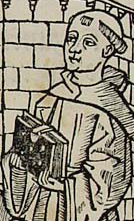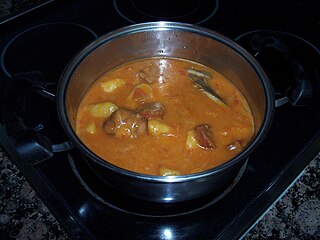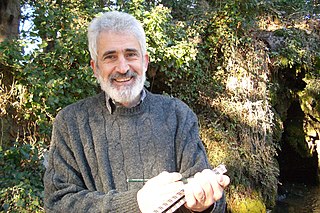Related Research Articles

Spanish cuisine consists of the cooking traditions and practices from Spain. Olive oil is heavily used in Spanish cuisine. It forms the base of many vegetable sauces. Herbs most commonly-used include parsley, oregano, rosemary and thyme. The use of garlic has been noted as "common to all Spanish cooking." The most used meats in Spanish cuisine include chicken, pork, lamb and veal. Fish and seafood are also consumed on a regular basis.

Catalan cuisine is the cuisine from Catalonia. It may also refer to the shared cuisine of Roussillon and Andorra, the second of which has a similar cuisine to that of the neighbouring Alt Urgell and Cerdanya comarques and which is often referred to as "Catalan mountain cuisine". It is considered a part of western Mediterranean cuisine.

A cookbook or cookery book is a kitchen reference containing recipes.

Alan Eaton Davidson CMG was a British diplomat and writer best known for his writing and editing on food and gastronomy.

An empanada is a type of baked or fried turnover consisting of pastry and filling, common in Southern European, Latin American, and the Philippines cultures. The name comes from the Galician verb empanar, and translates as "enbreaded", that is, wrapped or coated in bread. They are made by folding dough over a filling, which may consist of meat, cheese, tomato, corn, or other ingredients, and then cooking the resulting turnover, either by baking or frying.
In Catalan cuisine, crema catalana or crema cremada, is a dish that is similar to a crème brûlée; the desserts have been called "virtually identical".

Francesc Eiximenis, OFM was a Franciscan Catalan writer who lived in the 14th-century Crown of Aragon. He was possibly one of the more successful medieval Catalan writers, since his works were widely read, copied, published and translated. Therefore, it can be said that both in the literary and in the political sphere he had a lot of influence. Among his readers were numbered important people of his time, such as the kings of the Crown of Aragon Peter IV, John I and Martin I, the queen Maria de Luna, and the Pope of Avignon Benedict XIII.

Josep Carner i Puigoriol, was a Catalan poet, journalist, playwright and translator. He was also known as the Prince of Catalan Poets. He was nominated for the Nobel Prize in Literature seven times.
Josefina Tanganelli Plana was a Catalan cartoonist and painter.

The Llibre dels fets, originally spelled Libre dels feyts, is the autobiographical chronicle of the reign of James I of Aragon (1213–1276). It is written in Old Catalan in the first person and is the first chronologically of the four works classified as The Four Great Catalan Chronicles, all belonging to the early medieval Crown of Aragon, and its first royal dynasty, the House of Barcelona. James I inherited as a child the titles of King of Aragon, Count of Barcelona, and Lord of Montpellier, but also became by conquest King of Majorca and King of Valencia. James emphasises in his chronicles his conquest of Majorca (1229) and of Valencia (1238).
Le Ménagier de Paris is a French medieval guidebook from 1393 on a woman's proper behaviour in marriage and running a household. It includes sexual advice, recipes, and gardening tips. Written in the (fictional) voice of an elderly husband addressing his younger wife, the text offers a rare insight into late medieval ideas of gender, household, and marriage. Important for its language and for its combination of prose and poetry, the book's central theme is wifely obedience.
Jaume Fàbrega i Colom is a Spanish gastronomy writer, journalist, historian and professor at some universities. He has written more than fifty gastronomy and cooking books, he has won five times the Gourmand World Cookbook Award and he has made Ferran Adrià known over the world as a Catalan chef. He takes part of some international cultural associations as for example AICA and FIJET.
Josep Lladonosa i Giró, is a Catalan chef from the region of Lleida (Spain), and food-writer. He has been chef for fifty years. During this time he has also done a big research about cooking and gastronomy in Catalonia, which he has documented since the Middle Ages and he has diffused it in a large number of books and articles. Some of them have been translated in some languages as Spanish, English, French, etc. He is a famous gastronomy teacher as well. He has collaborated with people as Joan Amades or Jaume Fàbrega. In 2003 he won the highest Catalan award given by the Generalitat de Catalunya, the Creu de Sant Jordi.

Caterina Albert i Paradís, better known by her penname Víctor Català, was a Catalan writer in Catalan and Spanish who participated in the Modernisme movement and was the author of one of the signature works of the genre, Solitud (Solitude) (1905). Her literary skill was first recognized in 1898, when she received the Jocs Florals prize; soon thereafter, she began using the pseudonym Victor Català, taking it from the protagonist of a novel she never finished. Despite her success as a dramatist and her forays into poetry, she is best known for her work in narrative literature, with the force of her style and the richness of her diction being especially noted. She died in her hometown of l’Escala, Catalonia, in 1966 and is interred in the Cementiri Vell de l’Escala.
Powder-douce is a spice mix used in Medieval and Renaissance cookery. Like modern spice mixes such as "Italian seasoning," "garam masala," "taco seasoning," etc., there was not a set ingredient list, it varied from cook to cook. The author of the 14th-century manuscript Le Menagier de Paris suggested a mix of grains of paradise, ginger, cinnamon, nutmeg, sugar, and galangal.

Josep Maria Nadal i Farreras is Professor of History of Language at the University of Girona.

Guiso is a hot, mildly fatty food. Unlike stew, it allows the vapors to circulate during culinary process. In making guiso, a wide variety of ingredients may be used relative to region, season, availability, and taste.

Josep Lluís Martínez i Picañol, known by the pen name Picanyol[piˈkaɲɔl], was a Spanish self-taught comic artist. His best known creation is the warlock Ot el bruixot.
Salsa de pago is a type of salsa found in medieval Catalan cuisine. The recipe for capons served with salsa de pago can be found in the 16th-century cookbook Libre de coch. This dish was served for Christmas dinner. According to the Libre de coch recipe it was made with ginger, cinnamon, cloves and saffron. The name salsa de pagó comes from peacock that the sauce is intended for, but it can be served with other types of poultry. It is similar to the recipe from the 14th-century Llibre de Sent Soví.

Almadroc is a garlic-cheese sauce from medieval Catalan cuisine from the Llibre de Sent Soví. There is a similar recipe in the Llibre del Coch by Rupert de Nola for almadrote, a similar recipe for a sauce made with garlic, eggs, cheese and broth that was served with partridge. In modern usage it refers to an oil, garlic and cheese sauce served with eggplant casserole. Almadrote may have pre-Inquisition Sephardic origins and served with eggplant has become widespread in modern Turkish cuisine.
References
- ↑ Andrews, Colman (14 December 2012). Country Cooking of Italy. Chronicle Books. p. 190. ISBN 978-1-4521-2392-9 . Retrieved 16 March 2014.
- ↑ Page, Jutta-Annette (2004). Beyond Venice: Glass in Venetian Style, 1500-1750. Hudson Hills. p. 88. ISBN 978-0-87290-157-5 . Retrieved 16 March 2014.
- ↑ Davidson, Alan (1 January 1981). National & Regional Styles of Cookery: Proceedings : Oxford Symposium 1981. Oxford Symposium. p. 177. ISBN 978-0-907325-07-9 . Retrieved 16 March 2014.